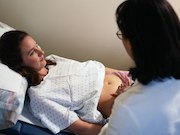Performance of screening as recommended by NICE guidelines was poor, with low compliance
FRIDAY, March 16, 2018 (HealthDay News) — First trimester screening for pre-eclampsia (PE) can be improved using a combination of maternal factors and biomarkers, according to a study published online March 14 in Ultrasound in Obstetrics & Gynecology.
Min Yi Tan, M.D., from King’s College Hospital in London, and colleagues conducted a prospective multicenter study involving women with singleton pregnancies at 11 to 13 weeks’ gestation who had measurements of mean arterial pressure (MAP), uterine artery pulsatility index (UtA-PI), serum placental growth factor (PlGF), and serum pregnancy-associated plasma protein-A (PAPP-A). The primary comparison for predicting PE was the detection rate (DR) using the National Institute for Health and Care Excellence (NICE) method versus the mini-combined test (maternal factors, MAP, and PAPP-A).
PE at any gestational age (all-PE) developed in 2.8 percent of the 16,747 pregnancies, while preterm PE developed in 0.8 percent. The researchers found that the screen-positive rate was 10.3 percent by the NICE method, and the DR for all-PE and preterm PE was 30.4 and 40.8 percent, respectively. There was only 23 percent compliance with the NICE recommendation that women at high risk for PE be treated with aspirin from the first trimester to the end of pregnancy. The DR of the mini-combined test for all-PE was 42.5 percent. The combination of MAP and PlGF to screen for preterm PE correlated with a DR of 69.0 percent; with the addition of UtA-PI, the rate increased to 82.4 percent.
“The performance of screening for PE as currently recommended by NICE guidelines is poor and compliance with these guidelines is low,” the authors write.
PerkinElmer Life and Analytical Sciences and Thermo Fisher Scientific provided reagents and equipment for the measurement of serum placental growth factor free of charge.
Copyright © 2018 HealthDay. All rights reserved.








